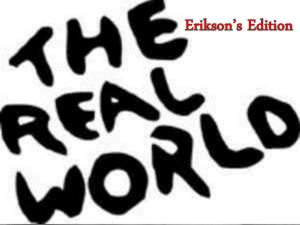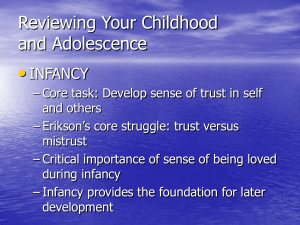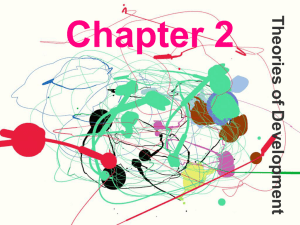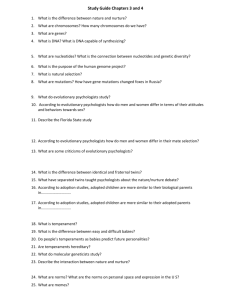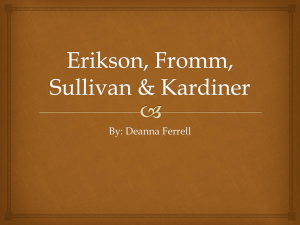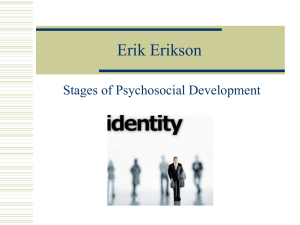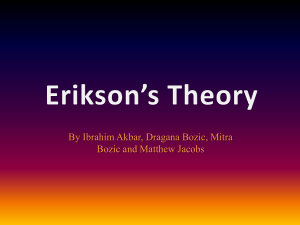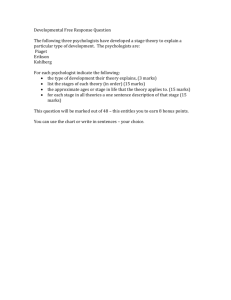Assignment 5: Case Studies 5 & 6 Psy 340: Personality Dr. Eddie
advertisement
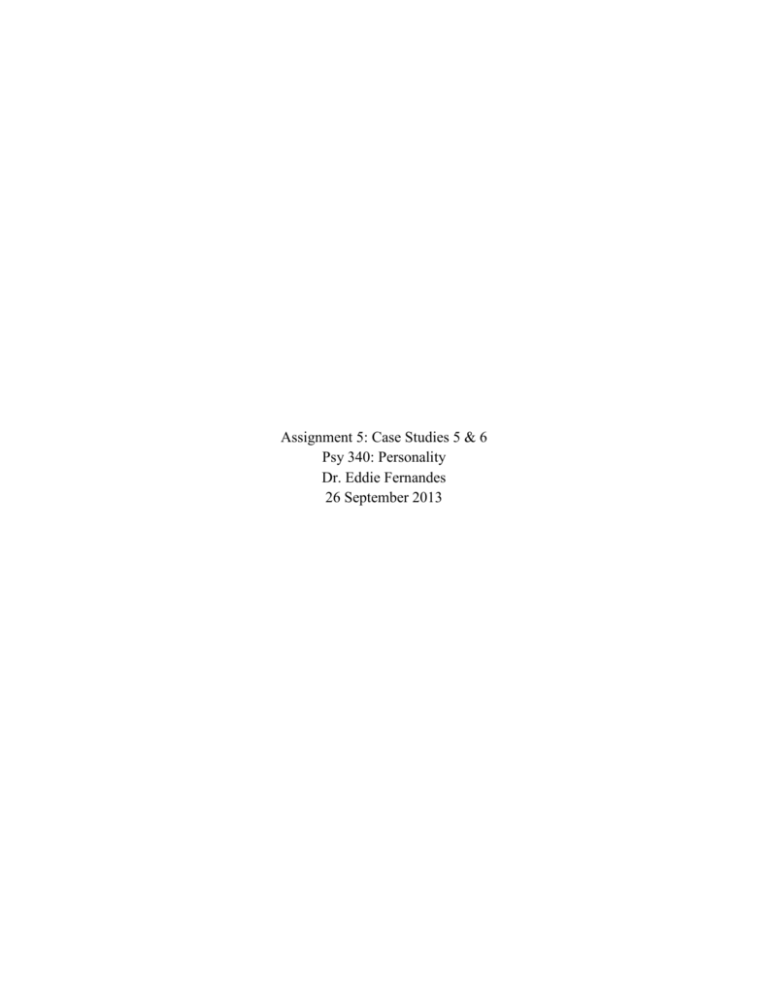
Assignment 5: Case Studies 5 & 6 Psy 340: Personality Dr. Eddie Fernandes 26 September 2013 Case Study 5 Application Questions 1. What is the crisis experienced in Erikson’s first stage of psychosocial development? How did Chrystell resolve this stage? What was the outcome of the crisis? What is favorable or unfavorable? a. First stage: Oral-Sensory Stage: Basic Trust versus Mistrust i. Child learns through the mother the basic concepts of trust or mistrust based on how the mother acts towards the child (happy and involved mothers lead to a trusting infant while aloof and cold mothers lead to a mistrusting infant). b. Chrystell resolved this stage in a healthy manner, meaning she came out of it with trust towards others. Her mother was always there for her in the first few years of her life and was always supportive. She was never cold, aloof, or absent when she was needed. This led to Chrystell resolving this stage in a favorable manner. 2. What is the crisis experienced in Erikson’s second stage of psychosocial development? How did Chrystell resolve this stage? What was the outcome of the crisis? Was if favorable or unfavorable? a. Second Stage: Muscular-Anal Stage: Autonomy versus Shame and Doubt i. Child learns potty training and, during the process, learns social rules. Through the resolution of this stage, a child can feel either autonomy (pride towards one’s self) or a sense of shame/doubt towards one’s self. b. During Chrystell’s childhood, her parents were always supportive and reinforcing in their actions towards her. When she was learning potty training, her parents never scolded her for having accidents. Instead, they encouraged that she could do better next time and not to worry. These behaviors led to Chrystell’s healthy favorable resolution of this stage, leading to her sense of autonomy. 3. What is the crisis experienced in Erikson’s third stage of psychosocial development? How did Chrystell resolve this stage? What was the outcome of this crisis? Was it favorable or unfavorable? a. Third Stage: Locomotor-Genital Stage: Initiative versus Guilt i. Children become more open towards the world and themselves, learning more about their own bodies and their external surroundings. During this stage, children’s imaginations race allowing them to explore a vast range of opportunities through play activities. They also begin to fantasize about “possessing” their opposite sex parent while “dethroning” their same sex parent. If their parents scold and punish them for this advancement, they develop guilt. If their parents guide and direct them towards socially acceptable behaviors in a positive manner, they gain a sense of pride. b. During this stage of her development, Chrystell’s parents provided a positive and supportive environment for her to explore her imaginative growth. Instead of forcing her to partake in specific play activities, their parents provided multiple options and let Chrystell chose which one she preferred to take part in. This constructive act of letting Chrystell choose led her to a favorable resolution of this stage of psychosocial development, leading to a sense of pride, because the option to choose her play activities allowed her imagination to thrive and let her become proud of herself and her actions. 4. What is the crisis experienced in Erikson’s fourth stage of psychosocial development? How did Chrystell resolve this stage? What was the outcome of the crisis? Was it favorable or unfavorable? a. Fourth Stage: Latency Stage: Industry versus Inferiority i. Children develop a sense of industry (feeling confident in their abilities to thrive) from identifying with their parents and teachers as people who constructively teach how to be confident in their own innate abilities and self-worth to society. If they do not resolve this conflict, they gain a sense of inferiority (feeling self-conscious towards their abilities and feeling that they cannot be an effective member in society in later life). b. At first, Chrystell was on the road to resolving this stage unfavorably, leading to inferiority, due to the birth of her younger sister. Having a younger sister around caused her parents to shift most of their attention towards her instead of Chrystell. This caused jealousy and anxiety in Chrystell because she thought her parents favored her sister over her. This anxiety caused her to obtain a stutter and selfconfidence issues, but when her little sister got a few years older, her mother began to divide her attention evenly between the two children, allowing Chrystell to overcome her feelings of jealousy, anxiety, and low self-efficacy, thus allowing her to overcome this conflict in a favorable manner, leading to a feeling of industry. 5. Erikson’s theory is sometimes described as a good guide for parents. Find examples of this guidance in the case study and describe them. a. In Erikson’s stages of development, a common theme is that parents should not be overbearing – instead they should encourage the autonomy and abilities of the child to thrive on their own through the guidance of the parents. Some examples of this in the case study are as follows: i. Chrystell’s parents positively reinforcing the act of potty training by not scolding her when she had accidents. ii. Chrystell’s parents allowing her to choose which play activities to take part in. iii. Chrystell’s parents encouraged her to walk, hold a spoon, and feed herself at her own pace instead of forcing the acts on her before she was ready. Theory Comparison Questions 1. How would Maslow’s theory explain Chrystell’s experiences? Are all her needs fulfilled? Explain. How do Maslow’s needs compare with the crises in Erikson’s stages? a. Maslow’s theory of basic needs (Hierarchy of Needs) states that people progress through life by obtaining specific needs to sustain life in a specific order: i. Physiological Needs: breathing, food, water, sleep, homeostasis, excretion of waste, etc. ii. Safety Needs: security of body, employment, resources, family, etc. iii. Love/Belonging Needs: friendship, family, sexual intimacy iv. Esteem Needs: self-esteem, confidence, achievement, respect from others, etc. v. Self-Actualization Needs: morality, creativity, spontaneity, problem solving, etc. b. According to Maslow, Chrystell progressed through life by healthily fulfilling these needs. She started by fulfilling the basic physiological needs followed by safety needs (around ages 4-12). Because she is only age 8, she has not fully fulfilled all of these needs stated by Maslow, but you can see where she is starting to grasp the idea of some of them, such as belonging in the family and the development of positive self-efficacy. c. Maslow’s needs compare well with Erikson’s stages of development. Although they may not be exactly the same in terms of development through aging, many of Maslow’s needs are similar to Erikson’s stages of psychosocial development: Maslow’s Needs Erikson’s Psychosocial Development Physiological Needs Oral-Sensory and Muscular-Anal Stages Safety Needs Muscular-Anal Stage (Autonomy vs. Shame and Doubt) Love/Belonging Needs Industry vs. Inferiority Self-Actualization Needs Identity vs. Role Confusion 2. Use Bandura’s concept of reciprocal determinism to explain how Chrystell’s stuttering was resolved after her baby sister was born. How is Bandura’s theory different from Erikson’s in its emphasis? a. Bandura’s concept of reciprocal determinism states that an individual is both influenced by and influences their personal factors, the environment around them, and other people. In other words, while a person is influenced by their surroundings, that person also influences those around them as well. b. According to Bandura’s theories, Chrystell’s stuttering was likely caused by an excess amount of stress caused by the birth of her sister. Because she is influenced by her environment, this stress manifested itself in the form of a stutter. It was not until after the younger sibling became 2 or 3 that her stuttering was resolved. It is likely that her stuttering, while caused by her environment, also influenced her mother to spend more time with her (ergo influencing the environment as well). This caused a decrease in Chrystell’s amount of stress and jelousy and, as a result, resolved her stuttering. c. While both Erikson and Bandura focused on an individual’s personal factors, they differ in the sense that Erikson also focused on parental and authority figure involvement in a child’s life while Bandura focused on everyone in the environment as a whole – not just parents and teachers, but friends and other people as well. 3. How could Sullivan’s good mother/bad mother personification explain Chrystell’s breastfeeding experiences? How is the emphasis of Sullivan’s theory similar to that of Erikson’s? a. According to Sullivan, the bad mother personification grows out of the child’s bad experiences with the mother’s nipple due to lack of fulfilling their hunger needs. The good mother personification then grows when the child becomes mature enough to recognize the cooperative behavior between them and their mother. b. Chrystell’s breastfeeding habits as an infant can relate to the good-mother personification. Instead of finding a lack of food based needs from the mother, she quickly realized that it was a cooperative effort between both her and her mother. Therefore, Chrystell only sought nourishment when she needed it and when her mother would give it, not whenever her mother thought it was ready for her. 4. How does Erikson’s concept of initiative compare with Rotter’s concept of locus of control? a. Rotter’s locus of control had 2 aspects: i. External Locus: life is dictated by external factors (fate) ii. Internal Locus: life is dictated by internal factors (one’s own abilities) b. Erikson’s concept of initiative is greatly similar to Rotter’s concept of internal locus of control. Both state that the child has the ability to choose what to do and where to go in life. The contrast to initiative, according to Erikson, is guilt, which is characterized by a feeling of being unaccepted and, as Rotter would say, one’s life being ruled by others (which is similar to his external locus of control). Case Study 6 Application Questions 1. Would Erikson’s theory suggest that Betty’s behavior is internally or externally motivated? What motivates it? Which system of personality is most involved in personality, according to the theory? a. According to Erikson, Betty’s behaviors are widely externally motivated, meaning they are driven by external forces. These include her parents (as a child) and her husband (as an adult). This behavior is likely motivated by the fact that her parents were overbearing and non-supportive, and they always compared her to her older brother of higher standards. This led to a dependent lifestyle where she needed external drives to motivate her behaviors. b. The system of personality involved in this would be the ego, primarily dealing with her ego-identity. Her ego-identity is how she determines who she is and what she aspires to be. Because Betty relies on other people and outside forces to motivate her, her ego is impaired, especially in terms of ego-identity. 2. What is the crisis experienced in Erikson’s fourth stage of psychosocial development? How did Betty resolve this stage? What was the outcome of the crisis? Was it favorable or unfavorable? a. Fourth Stage: Latency Stage: Industry vs. Inferiority i. Children develop a sense of industry (feeling confident in their abilities to thrive) from identifying with their parents and teachers as people who constructively teach how to be confident in their own innate abilities and self-worth to society. If they do not resolve this conflict, they gain a sense of inferiority (feeling self-conscious towards their abilities and feeling that they cannot be an effective member in society in later life). b. Based on the information given in the case study, Betty did not resolve this conflict in a favorable manner. She views herself as “Plain Jane,” meaning she does not think there is anything special about her that makes her unique. In her own eyes, Betty is just another girl trying to make a life for herself – nothing more. This illustrates the inferiority side of Erikson’s conflict at this stage. 3. What is the crisis experienced in Erikson’s fifth stage of psychosocial development? How did Betty resolve this stage? What is the outcome of the crisis? Was it favorable or unfavorable? a. Fifth Stage: Adolescence: Identity vs. Role Confusion i. Individuals develop a sense of identity as to who they are. Individuals who progress through the previous stages in a healthy manner develop a sense of “being somebody” and a sense of uniqueness (identity). Individuals who progress through this crisis in an unhealthy manner develop a sense of role confusion, characterized by feelings of incompetence and inadequacy. b. Betty progressed through this stage in an unhealthy manner as well. Healthy individuals gain a sense of self-confidence in who they are and who they want to become. This is not the case with Betty, as illustrated by the quote, “She went to school for education, which was the acceptable major for girls at that time.” This like illustrates how Betty did not strive for individuality or identity, but instead just to have a role. She didn’t feel like she had a role in life so she went for the most common role for people in her situation. With this said, clearly Betty’s resolution of this stage was unfavorable, leading to role-confusion. 4. What is the crisis experienced in Erikson’s sixth stage of psychosocial development? How did Betty resolve this stage? What was the outcome of the crisis? Was it favorable or unfavorable? a. Sixth Stage: Young Adulthood: Intimacy vs. Isolation i. Individuals who have progressed through the previous stages in a healthy manner reach this conflict and can either gain a sense of intimacy, which is the ability to have a true relationship based on common values and interests, or a sense of isolation, characterized by the inability to be in an intimate relationship and the inability to take chances with one’s identity. b. Betty did not resolve this conflict favorably. She did not date while she was in college. The only person she had interest in did not show interest back, therefore causing her to believe she was not worth anything in other peoples’ eyes. It wasn’t until she met Cole did she feel a slight bit of feelings towards someone else. When Cole proposed via letter, Betty claimed that she accepted the proposal because she thought she would never find someone who would want to marry her again. As a result, this relationship never truly became intimate, thus leading Betty to a life of isolation. 5. What is the crisis experienced in Erikson’s seventh stage of psychosocial d3evelopment? How did Betty resolve this stage? What was the outcome of the crisis? Was it favorable or unfavorable? a. Seventh Stage: Middle Adulthood: Generativity vs. Stagnation i. Individuals who progress through this conflict healthily gain a strong ego identity and mature relationships with others. Generativity involves the process of establishing and/or enhancing a creative and productive career while being concerned with the well-being of the next generation. Stagnation involves a lack of productivity, boredom, and interpersonal impoverishment. b. Betty did not resolve this conflict healthily. Instead of obtaining a sense of generativity, she gravitated towards stagnation because she did not enhance her relationship with her husband (she said it never truly escalated to anything more than what it was when they were married). She quit her career as a teacher to become a stay-at-home mother, which led to an even more heightened sense of stagnation. 6. What could be expected in the eighth stage of Betty’s life, according to Erikson’s theory? a. Eighth Stage: Late Adulthood: Ego Integrity vs. Despair i. Individuals who reach this stage in a healthy manner look at their life in pride and do not fear death. This is called a sense of ego integrity. Those who do not reach this stage in a healthy manner look at their life in disappointment. They want to redo it over again because they think they can do it better. They fear death because they do not want to die having lived a meaningless life. b. Based on the information in the case study, Betty will likely reach this stage and gravitate towards despair. She does not like her life. She wishes she could go back and do it again starting with her husband. The case study says that Betty wants to divorce her husband because she is simply unsatisfied. She looks back on her life and wishes she could do it again, causing a sense of despair in her life. Theory Comparison Questions 1. Which of Fromm’s needs have been met for Betty? Which have not? Explain. How does Fromm’s theory compare with Erikson’s in their consideration of social influence? a. The following is a list of Fromm’s 8 needs: i. Relatedness with others ii. Transcendence (overall good outlook on their life and the ability to be happy/proud of it) iii. Rootedness (the need to establish roots in one’s life) iv. Sense of Identity v. Fame of Orientation (understanding one’s place in the world) vi. Excitation and Stimulation (actively striving for a goal) vii. Unity viii. Effectiveness (need to feel accomplished) b. According to the information given in the case study, Betty achieved Rootedness, but none of the other 7 needs (even then, she had to fight for rootedness). All of these needs are characteristic of someone who develops healthily throughout life, which Betty did not do. Therefore, it is safe to say that she did not truly achieve any of Fromm’s 8 basic needs of development. c. Fromm’s theory is similar to Erikson’s concepts of the development conflicts. Each of the above needs by Fromm can be related to a corresponding developmental conflict by Erikson. Erikson just goes further in depth with the actual conflict and how to achieve the above needs. 2. How would Rogers’ concept of conditions of worth explain Betty’s career choice? Her marriage to Cole? How is the emphasis of Rogers’ theory different from that of Erikson’s? a. Conditions of Worth states that people who were raised in an environment where they were treated with unconditional positive regard gained an unconditional sense of self-worth. Those who were raised in an environment of conditional affection only gain a sense of worth when they feel that certain conditions have been met. b. This can explain Betty’s career choice because she grew up in an environment of conditional positive regard, meaning she only received praise or affection when she did something that was worth praise. As a result, in order to please her parents she decided to go into the field of education, because only by pleasing her parents and those around her could she feel any sense of self-worth. c. Rogers theory is similar to that of Erikson’s, but it is more overarching instead of focusing on specific individual developmental processes. Erikson touches on the idea of self-worth in that individuals who progress through the stages healthily obtain a sense of ego-identity and can be proud of their accomplishments unconditionally. Rogers, on the other hand, states that individuals can only obtain this if they grew up in the proper environment. 3. At what Jungian stage could Betty be placed? Why? How do Jung’s stages compare with those of Erikson? a. Even though Betty is 68 years old, Jung would likely place her in the Middle Adulthood stage of development. The reason she is not in Old Age is because this stage is characterized with a coming-to-terms with one’s life and seeing it as reason to be proud, and that death is not something to be feared. This does not describe Betty at all. Betty looks back on her life in despair wishing she could do it all over again. She fears death and wishes to recapture her youth – the defining characteristics of Jung’s middle adulthood stage. b. Jung’s stages of development are similar to Erikson’s, but are not as specific. Jung believed that the personality develops gradually over one’s entire lifetime, not at specific increments like Erikson. The two theorists are so similar in every other aspect that it is almost as though Erikson’s stages are like substages to Jung’s stages of development: i. Childhood (Jung) 1. Oral-Sensory: Basic Trust vs. Mistrust (Erikson) 2. Muscular-Anal: Autonomy vs. Shame and Doubt (Erikson) 3. Locomotor-Genital: initiative vs. Guilt (Erikson) 4. Latency: Industry vs. Inferiority (Erikson) ii. Youth (Jung) 1. Adolescence: Identity vs. Role Confusion (Erikson) 2. Young Adulthood: Intimacy vs. Isolation (Erikson) iii. Middle Life (Jung) 1. Middle Adulthood: Generativity vs. Stagnation (Erikson) iv. Old Age (Jung) 1. Late Adulthood: Ego Integrity vs. Despair (Erikson)
